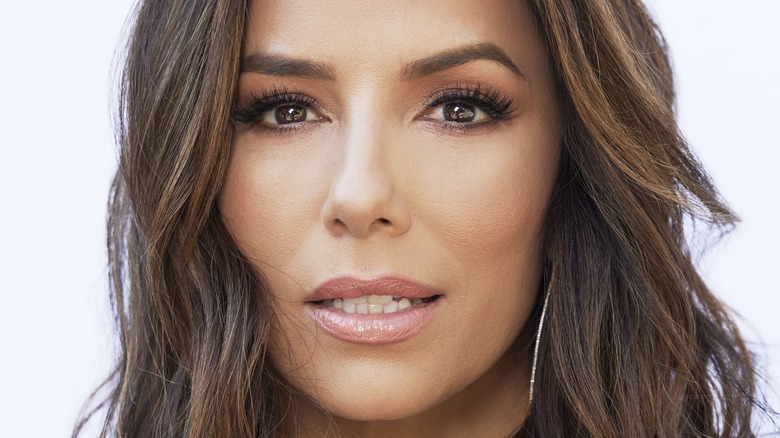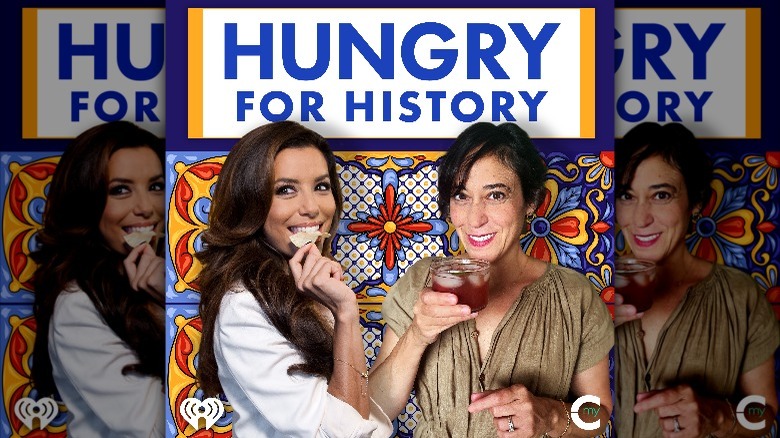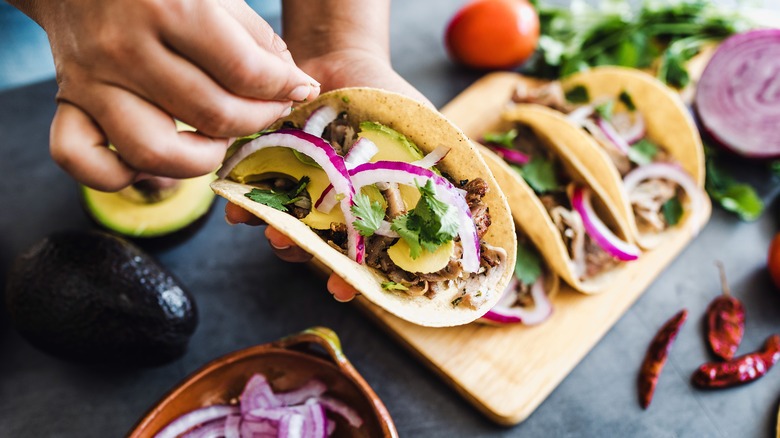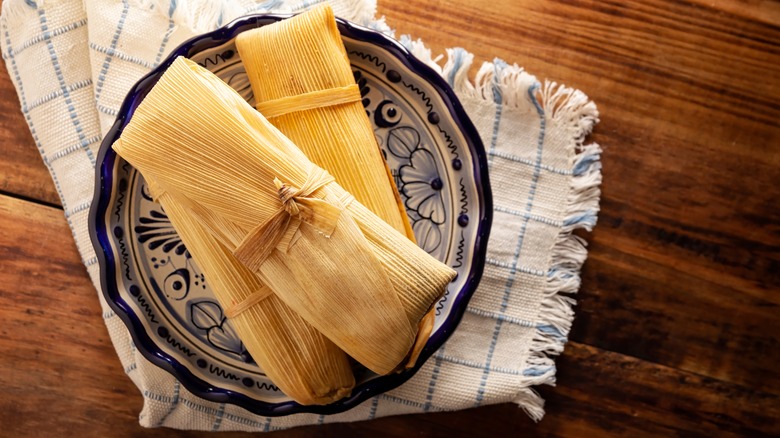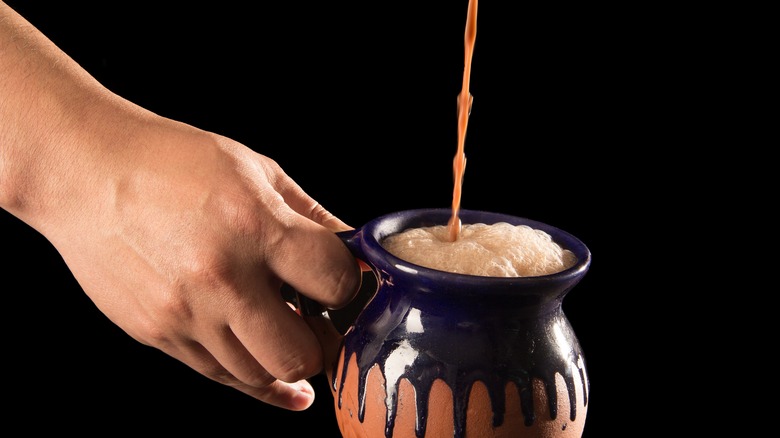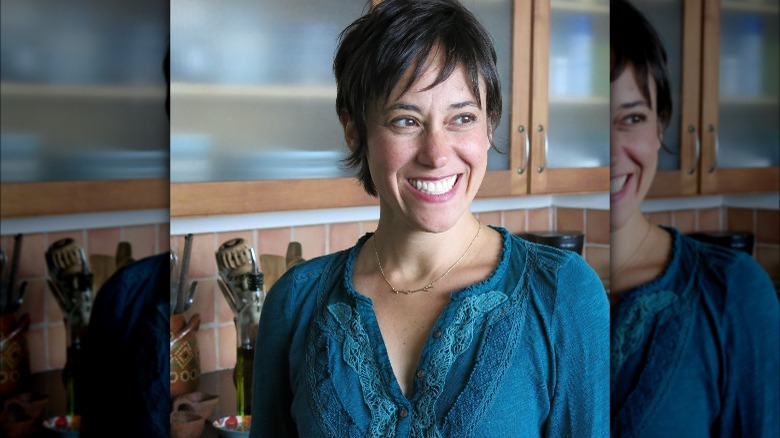Eva Longoria And Maite Gomez-Rejón Talk All Things Latin Food On Their New Podcast - Exclusive Interview
Eva Longoria, a well-known face in television, found a niche in the podcast industry. The "Desperate Housewives" star has been in a myriad of films, with her most recent business ventures covering the food and beverage space. Longoria paired up with Pillsbury over the summer, created a tequila brand (Casa del Sol), and even co-founded her own cookware line. The "Searching for Mexico" host has no shortage of food knowledge as the CNN show focuses on her culinary experiences throughout Mexico.
Now, Longoria started a new podcast with culinary historian, Maite Gomez-Rejón, to focus on her family's culture and the history of Latinx foods. In an exclusive interview with Tasting Table, the actress revealed her tortilla preferences, favorite Los Angeles taco spot, and what inspired her new podcast, "Hungry for History," with iHeartMedia's My Cultura Podcast Network. Additionally, Gomez-Rejón told Tasting Table via email her most shocking culinary food fact and underrated Latin food. Safe to say you can learn a thing or two from Longoria and Gomez-Rejón!
Why Longoria started the Hungry for History podcast
I would love to start with what inspired you to start your new podcast, "Hungry for History."
Eva Longoria: I am obsessed with food, history and art. I met Maite Gomez-Rejón, and she's the only other geek I knew that was as excited about those three things. I was like, "We could talk about Mexican vanilla for five hours. There must be other people like us in the world." Sure enough, there are.
We decided to do this fun broadcast about Latin culture foods, specifically the food from our culture and the history of it. A lot of people don't realize the tomato is endemic to Mexico, chocolate is endemic to Mexico, the plantain that is known in the Latinx culture is endemic to Africa. Food really connects us and lets us understand different cultures better.
You guys definitely covered a niche, I would say, in the podcast industry. In the intro for the podcast, you mentioned that you enjoyed flour tortillas instead of corn tortillas.
Yes, I know. Very controversial.
It definitely is. What would you say are your favorite taco ingredients to pair with flour tortillas?
Everything. My favorite is a bean taco in the morning. I've eaten the bean taco my entire life in the morning. It's like a refried pinto bean and my flour tortilla [with] butter on the tortilla. My son and I would eat that in the morning, as well. Fajitas are much better with flour tortillas. Barbacoa, which is shredded beef cheek, is better with flour tortillas. There's so many things that are with flour tortillas.
Longoria divulges on her travels in Mexico and favorite spot
What would you say your favorite taco spot in Los Angeles would be?
King Taco out in East LA. King Taco, that's the spot to go.
What would you normally order from there?
Everything. Tacos el pastor, tacos de rib eye, which is rib eye tacos, carnitas, and always with lots of salsa, red salsa, green salsa, avocado, guacamole salsa. You have to have all the toppings.
I know you visited Mexico for your podcast and your CNN series. What would you say is the most interesting food experience you've had during your travels to Mexico?
There's too many to name, but one of the most beautiful experiences I had was the vanilla fields in Mexico. Mexican vanilla is the original vanilla in the world, even though 80% of it is now produced in Madagascar. It's endemic and native to Mexico, and that's why if you go to the store and you see a real Mexican vanilla, it's like $45. You're like, "Wait, how is this $45?" [It's] because it's very rare and it's so different, tastes different, reacts differently, and mixes well.
It's a plant that doesn't have a natural pollinator. It used to be pollinated by these special bees that have all died out in Mexico. Now, you have to pollinate the vanilla bean by hand. The fact that this is done by hand and they only bloom once a month and they only bloom one hour a day during that month, and it's all done by hand, it's super labor intensive and that's expensive. It's the second most expensive spice after saffron. It was very educational, but also something romantic about the history of vanilla because we use it in so many things.
Longoria reveals what makes tamales so special
Is there a family recipe from your childhood that you still make today?
Everything. Mostly Mexican food, but the bean taco in the morning is something my mom made for me and I make for Santi. Tamales at Christmas, that's a pretty big tradition for us.
That's actually a good segue into my next question. I saw in a previous interview that you did with Yahoo! Life that you mentioned tamales are one of the happiest things you cook during Christmas time. With the holidays coming up, is there a special or a secret ingredient you put in your tamales?
We do all of them. We make about eight different kinds. It's pretty traditional. We don't really mess with the tamales, but the pork ones are the traditional ones, so those are my favorite.
Do you have any tips on how to make that recipe at all for anyone who's looking to try it?
You have to have a lot of primas and primos, which means a lot of cousins, aunts and uncles, because it is labor-intensive and you need an assembly line of labor.
That's what makes it fun, right? It's the holidays with your family.
Totally, and it's called a tamalera, so you spend a day making them. You make a thousand, you never make ... "I'm going to make a dozen." No, no. When you make tamales, you're making a thousand, and everybody divides them up at the end of the day.
You have to have leftovers.
And it's such a fun tradition because you're drinking and you're spreading and rolling and it's pretty great.
Longoria wants you to try Mexican hot chocolate
Do you have any tips for wrapping tamales at all?
I like less masa [the outer layer] and it rolls better when you have less masa. You have to have a proportionate amount of masa and filling. It can't be too breaded because then it doesn't taste great and it doesn't roll great. You need a good ratio. Unfortunately, you still have to use lard. I'm sure there's healthier ways, but the secret ingredient really is lard.
What would you say is your favorite Mexican-influenced holiday dessert, and why?
I really love Mexican hot chocolate. It's not a dessert, it's a drink. It's chocolate being native to Mexico, but specifically Mexican hot chocolate, it has a different flavor than hot chocolate. That's when you say, "Oh, it's Mexican hot chocolate," it tastes totally different. Lately I have been adding my tequila to it, so it's almost like the Mexican hot toddy because I add tequila inside the hot chocolate and it is warm and delicious and so good and very dangerous.
What would you say is the difference between regular hot chocolate, is Mexican hot chocolate spicy at all? What is it normally like?
No, it's super smooth and luscious and rich and creamy. You have to have the bars of Mexican hot chocolate. They come in these bars, and you melt it down. You can make that with almond milk and it still tastes amazing. You can have oat milk or almond milk. You can have a milk substitute with that Mexican hot chocolate bar because it does all the work.
Maite Gomez-Rejón on historical food facts
What makes "Hungry for History" different from other food podcasts?
Maite Gomez-Rejón: Good question! A lot of food history podcasts out there — or at least the ones that I listen to — are more academic in nature. Eva and I want people to feel like they're part of the conversation rather than be lectured to and although we delve deep into food history, we keep it conversational and fun.
What do you think is the most underrated Latin food in the U.S.?
Latin American food is so diverse! We're focusing on Mexican food and as much as people love a good taco, it's seen as cheap street food, but that tortilla tells a big story. Mexican food is complex. It's not just Taco Tuesday or Margarita Monday. It's bound to the land and to the centuries of people that have been through it. We follow the foods to tell those stories.
While working on the podcast, what's the most surprising historical food fact you have learned?
I've been obsessively researching food history for many years and continue to be amazed with how much there always is to learn. What has been most striking for me while working on the podcast is how food history is constantly evolving. The conversations we are having today about economic policies and climate change will affect how people will study food in the years to come.
On a micro level, going to a vanilla field in Veracruz and seeing vanilla being hand pollinated completely blew me away. The person that figured out how to do that was a 12-year old enslaved boy in 1841 in the Reunion Island. You'll have to tune in to the vanilla episode to hear more!
Listen to iHeartMedia's "Hungry for History" podcast on the website. Check out Eva Longoria's Instagram page to keep up with her latest projects.
This interview has been edited for clarity and formatting.
